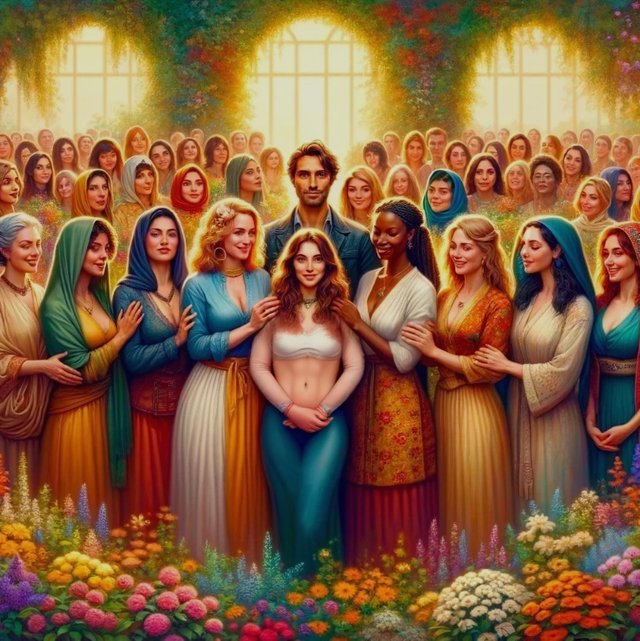The Intriguing Dynamics of Harems: Benefits, Interactions, and Modern Views
Key Takeaways:
- Harem Lifestyle: Both historical and modern perspectives show the intricate social and educational dynamics within harem structures.
- Benefits of Harems: Key advantages include emotional support, shared responsibilities, and strong community bonds.
- Polygamy vs. Monogamy: Examining the differences in social and biological dynamics between polygamy and monogamy, with insights from primate studies.
- Modern Harems: Contemporary examples highlight ethical and social challenges, alongside the luxurious lifestyles of modern harem holders and their members.
- Why One Male is Better: Limiting the number of males in a harem reduces competition and increases stability.

Introduction to The Epic World of Modern Harems
First off I would like to express that I was born in America, so this is a topic that a lot of people here see as "taboo" as it goes against the Modern American Judaeo-Christian narrative of "one man one woman"(it's almost like they didn't read their own book lol).
The concept of harems has captivated many, blending historical, sociological, and psychological elements. Often misconceived as mere collections of concubines, harems have historically functioned as complex social institutions where women could wield significant influence. Today, harems exist in various forms, each with its unique benefits and challenges.
Harem Lifestyle
Historical Context and Daily Life:
Historical harems, such as those in the Ottoman Empire, were intricate social structures. Women in these harems, especially those in positions of influence like the Valide Sultan (the Sultan's mother), held substantial power. Harems were centers of education and social maneuvering, where young girls were trained in various disciplines to prepare for influential roles within the palace. This historical perspective is well-documented in sources like Britannica and Wikipedia.

Benefits of Harems
Emotional and Social Support:
Polygamous relationships, such as those found in harems, provide deep emotional connections and a robust support system. Communal living arrangements foster strong bonds among members, who share responsibilities and resources, enhancing the household's overall stability and functionality. These structures can offer emotional and social benefits that are often less prevalent in monogamous setups. For more insights, refer to the article on the Pros and Cons of Polygamy.
Polygamy vs. Monogamy
Biological and Social Dynamics:
Polygamy, particularly polygyny (one man, multiple women), is a common mating system in nature and has been practiced by various human societies throughout history. The primary difference between polygamy and monogamy lies in their social and psychological dynamics. While monogamy focuses on a one-to-one partnership, polygamy allows for multiple spouses, leading to more complex relational dynamics but potentially stronger community bonds when all members align.
Studies on primates, such as the Yunnan snub-nosed monkeys, show that males with larger harems often achieve higher reproductive success, while females' reproductive success is less affected by harem size. For more details, refer to the study on Harem Size in Polygynous Primates.

Modern Harems
Contemporary Examples and Challenges:
Modern harems, though less common, still exist and often in controversial contexts. Wealthy individuals like the Sultan of Brunei and King Mswati III of Swaziland maintain large harems as part of their luxurious lifestyles. These modern harems often differ significantly from historical ones, being associated with wealth and power rather than cultural or religious practices.
Ethical issues and allegations of coercion sometimes arise, highlighting the challenges these arrangements face in contemporary society. For an in-depth look, read the article on Modern Day Harems.
Why One Male is Better
Reducing Competition and Increasing Stability:
Limiting the number of males in a harem reduces competition and increases stability. High levels of testosterone in males lead to aggressive behavior and competition for mates and resources, resulting in conflicts that can disrupt the harem's harmony. A single male structure minimizes these issues, fostering a more peaceful and cooperative environment. This concept is supported by studies on Polygynous Primates and their social dynamics. Additionally, it is easier for a group of women to fend off one lone male if he becomes violent than for a single woman or even a group of women to fend off a bigger group of oppressive, violent males.
Conclusion
Harem lifestyles offer a unique blend of emotional support, social structure, and complex dynamics. While it may not be for everyone, we hope our insights have encouraged some to explore these ideas further.

Understanding the historical context and modern interpretations of harems helps appreciate the benefits and challenges these structures present. From historical harems to contemporary examples, the intricate dynamics and advantages of these arrangements continue to intrigue and provoke discussion.
FAQs on Modern Harems and Harem Lifestyles
Q: What are the main benefits of a harem lifestyle?
A: Harems offer deep emotional connections, shared responsibilities, and a strong sense of community among members. Learn more about the Pros and Cons of Polygamy.
Q: How do modern harems differ from historical ones?
A: Modern harems are often associated with wealth and power, whereas historical harems were intricate social institutions with significant educational and political roles. Read about Modern Day Harems.
Q: Why is limiting the number of males in a harem beneficial?
A: Limiting the number of males reduces competition and aggression, leading to a more stable and harmonious environment. This is elaborated in this study on Harem Size in Polygynous Primates.
Q: What are the ethical concerns surrounding modern harems?
A: Modern harems often face ethical issues such as accusations of coercion and exploitation, highlighting the need for consensual and respectful relationships. For more details, refer to this article on the Pros and Cons of Polygamy.
Q: How does polygamy compare to monogamy in terms of social dynamics?
A: Polygamy involves more complex social dynamics due to multiple spouses, which can lead to stronger community bonds but also increased competition and jealousy. This is discussed in the context of Polygynous Primates.
For more detailed insights, you can visit this article here.